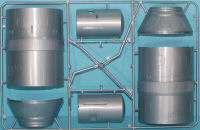
Revell 1/24 Vostok I Kit First Look
By Michael Benolkin
| Date of Review | July 2011 | Manufacturer | Revell |
|---|---|---|---|
| Subject | Vostok I | Scale | 1/24 |
| Kit Number | 0024 | Primary Media | Styrene |
| Pros | Great to see this classic kit back on the market | Cons | Nothing noted |
| Skill Level | Basic | MSRP (USD) | $30.25 |
First Look
 |
 |
 |
While scientists in the US were trying to create larger rocket boosters that could carry a payload into orbit, word came in early October 1957 that the first man-made satellite had achieved orbit. That satellite was Sputnik and it came from the Soviet Union. That news put significantly more priority and resources into the American effort as they went from pure research into a space race. As the fledgling NASA worked toward a workable spacecraft capable of keeping its pilot alive in space, news once again came that Cosmonaut Yuri Gagarin had made it into space. Unlike Sputnik however, Gagarin was on a trajectory that put his Vostok spacecraft almost one complete orbit before it fell back to Earth.
When you look at the Vostok versus the Mercury spacecraft, you can see how the two groups of scientists approached a series of engineering problems from different angles. For example, the Vostok looks like a pressure vessel from a diving bell (and it works on the same principal). The Mercury was a lightweight airframe to compensate for the limited lift capabilities of early US launch vehicles. With a heavier pressure vessel, the Vostok could be pressurized to a comfortable level with a normal oxygen/nitrogen atmosphere.
The Mercury (and subsequent spacecraft) would have burst under that same pressure, so American astronauts breathed a pure oxygen atmosphere that required less pressure. With a normal atmosphere, the Vostok's instrumentation and support systems were simply subjected to standard flight safety as well as size/weight/power constraints. Those same systems in US spacecraft must also have additional engineering to prevent sparks or other ignition sources that could turn the interior of the spacecraft into a fireball (as happened on the launch pad with Apollo 1).
Revell/Germany continues to release classic kits for the third year in a row and in this case, we have the classic 1/24th scale Vostok I spacecraft. Molded in silver plastic, this kit is presented on three parts trees plus a single clear tree with the Yuri Gagarin's helmet visor and a clear pedestal for the display stand (not shown here).
As you can see in the images, this isn't a complex kit, but Revell did nicely capture the key elements of the spacecraft. First we have the Vostok ZRK which is the pressurized capsule and it was, as mentioned above, a sphere like a diving bell. The kit provides a removable entry hatch that reveals the cylindrical cockpit where Gagarin sat for his 100+ minute flight around the Earth. The kit provides the basics for the cockpit, a Cosmonaut figure to represent Yuri Gagarin, his ejection seat, and even a port hole (like that diving bell) to provide some visibility to the outside.
Next comes the third stage that carried flight instrumentation as well as attitude and thrust motors. This service module has the characteristic fuel/air cells mounted around the base of the fixture that held the capsule to the service module.
The kit provides a display stand to put your completed model into a nice display attitude.
Unlike when this kit was first designed many decades ago, there are some nice online photo references for the Vostok spacecraft so you can either build this model straight out of the box, or the AMS modeler will want to add some of the more subtle cable channels, antennas, and other details that were simply not available at the time.
While there were no distinguishing markings carried on this spacecraft, the instructions do provide painting recommendations that are based upon the original kit release's color instructions (silver, black, white - just like a typical early US spacecraft). Check some of the online photos and images of Russian company models to get an idea of the real colors carried by the early Vostok spacecraft.
It is nice to see this kit back on the marking and it provides a nice counterpoint to Revell's 1/24 scale Gemini spacecraft that was reissued some time back. Perhaps we might see it again one day soon. In the meantime, have some fun with this beauty and take a closer look at other differences between US and Russian engineering designs. It really underscores the point that there is more than one way to solve the seemingly monumental problem of keeping a human alive in space.







